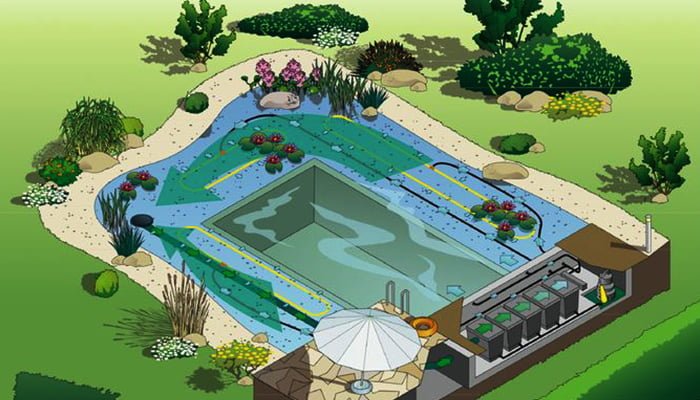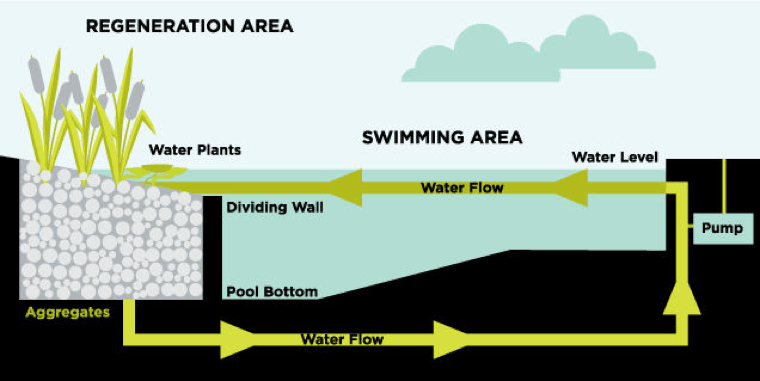A natural swimming pool is an in-ground swimming pool that utilizes natural processes to clean the water instead of harsh chemicals. The actual swim zone of natural pools exists below the surface of the water. To put it into perspective, imagine a wall; on one side is the regeneration (recharge) or “purification” zone, and on the other side there is a deeper swim zone. This allows the water to interact between both zones, but eliminates the stuff that’s doing the cleaning from entering the swimming area.
Natural swimming pools are already pretty common in places like Europe, and are gradually increasing in popularity in the United States. Not only are natural swimming pools aesthetically pleasing, but they also have many benefits.
Benefits of a natural swimming pool vs a chlorinated pool:
- 100% chemical free
- Natural swimming pools have separate zones for swimming and water purification, which mimics the biodiversity and function of the natural environment.
- No chemicals means no red eyes, bleached hair, dry itchy skin, or other negative effects associated with chlorine exposure. These negative effects are seen most commonly in children, as they are more susceptible and are often spending more extended periods of time in the water.
- The beautiful backyard aesthetic of plants and flowers suited to your climate (that regulate the natural cycle of the swimming pool) are part of the design and build project, as opposed to additional landscaping that would be needed/desired after a traditional chlorinated in-ground pool installation.
- The initial cost of a natural swimming pool is about equivalent to that of a standard in-ground swimming pool. But, the advantage of natural pools is the elimination of the annual costs of the chemicals needed to maintain a chlorinated pool.
- They require less maintenance, if the pool is well-designed and located. As with any aspect of your yard, routine upkeep and care will be needed, such as, maintaining proper plant care and preventing contamination from animals, fertilizers, and chlorinated waters, etc. The water temperature must not be heated above 85 degrees to maintain healthy bacteria growth.
Depending on the desired design, natural swimming pool zones typically comprise 50-70% of the total water surface area, and the remainder is dedicated to filtration. Water is circulated constantly from the swim zone through the shallow regeneration area. The plant life and aggregate act as natural filters, which keeps your natural water pure and clean.
It is important to note that your natural swimming pool water will be a light shade of green (closely resembling river water), but this does not mean it is dirty, or unclean. “I would say that I would actually drink the water from a natural swimming pool,” said Geography and Planning Specialist on Natural Pools, Matthew Fiduccia.
Hear more from Matthew in our detailed video on natural swimming pools below:
Your natural swimming pool will certainty allow for a different atmosphere than a chlorinated pool, as it will establish a habitat for flora and fauna that will attract wildlife like birds, frogs, or dragonflies. This wild life that will inhabit your chlorine-free water essentially serve as natural mosquito and stinging insect repellent, as they are their natural predators.
If you are interested in incorporating a natural swimming pool oasis to your backyard landscape design, the professionals at Red Cedar have the knowledge and expertise to design, construct, and install it for you properly. Contact us today for your free landscape design estimate, and turn your backyard into a spot that’s both vacation worthy and chemical free!



